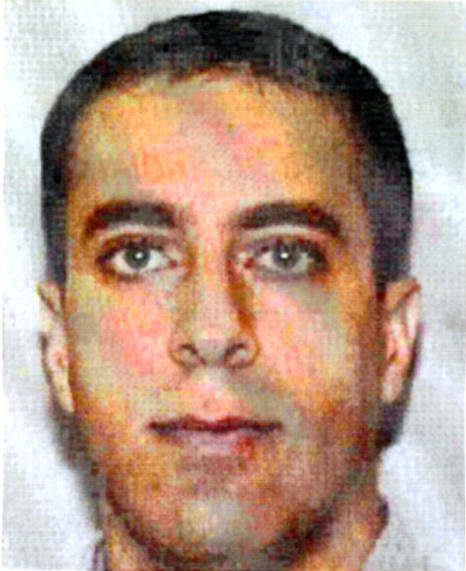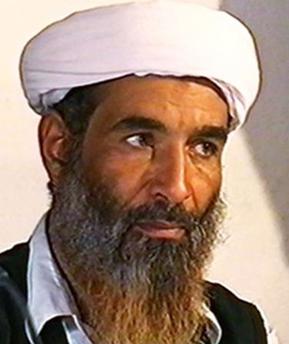Ihab Mohamed Ali Nawawi | |
|---|---|
 | |
| Born | ~1962 [1] |
| Other names | Nawawi [2] Abu al Tayar [3] Yousef Kanana [3] Abu Sulaiman [3] |
An Egyptian-American cab driver, Ihab Mohamed Ali Nawawi became a personal pilot to Osama bin Laden in the early 1990s.
Ihab Mohamed Ali Nawawi | |
|---|---|
 | |
| Born | ~1962 [1] |
| Other names | Nawawi [2] Abu al Tayar [3] Yousef Kanana [3] Abu Sulaiman [3] |
An Egyptian-American cab driver, Ihab Mohamed Ali Nawawi became a personal pilot to Osama bin Laden in the early 1990s.
Nawawi moved to the United States as a youth with his family, and attended an Orlando high school before traveling to fight in the Soviet invasion of Afghanistan. [1]
He trained at the Airman Flight School in Norman, Oklahoma, before joining the fledgling al-Qaeda in the Sudan. [4] [5] In the 1990s, he worked for the Muslim World League in Pakistan. [1]
L'Houssaine Kherchtou later testified in the United States that he had seen an Egyptian briefing Nawawi on air traffic control procedures, leading him to believe that an attack on an airplane, possibly in Saudi Arabia, was in the works. [6]
After Wadih el-Hage asked Essam al-Ridi to sell a private Sabre-40 jet on the Egyptian market, al-Ridi traveled to Khartoum where he met with Nawawi and the pair of them tried to repair the plane; however the brakes failed after a test flight with both men flying, and the plane crashed into a sand dune. The event attracted public attention, since the plane was unique in being a private aircraft at Khartoum International Airport and known to belong to Osama bin Laden. Worried that the Egyptian Mukhabarat would learn of his whereabouts, al-Ridi fled the Sudan. [7]
Nawawi returned to the United States in 1996. [1]
When Ali Mohamed moved to the United States, Nawawi helped him make the transition. [8] When Mohamed was arrested as a double agent working for both Egyptian Islamic Jihad and the CIA, a letter from Nawawi was discovered in his house that urged him to give "best regards to your friend Osama". [1] [9]
He was arrested May 18, 1999, in Orlando. [1] In September 2000, he was charged with contempt of court and perjury. [10] [11]
In March 2001, Nawawi pleaded guilty to perjury, criminal contempt and conspiring to kill U.S. nationals and agreed to cooperate with the prosecution. At a May 2009 sentencing, he received time served after spending a decade in prison and was released. [12]

Mohamed Mohamed el-Amir Awad el-Sayed Atta was an Egyptian hijacker and the ringleader of the September 11 attacks in 2001 in which four United States airliners were commandeered with the intention of destroying specific civilian, military, and governmental targets. He was the hijacker-pilot of American Airlines Flight 11 which he crashed into the North Tower of the World Trade Center as part of the coordinated attacks. Having just turned 33 at the time of the attacks, he was the oldest of the 19 hijackers who took part in the mission. Atta was directly responsible for the deaths of more than 1,600 people during the attacks.

Osama bin Mohammed bin Awad bin Laden, also transliterated as Usama bin Ladin, was a Saudi Arabian-born Islamist militant who was the mastermind behind the September 11 attacks and founder of the Pan-Islamic militant organization al-Qaeda. The group is designated as a terrorist group by the United Nations Security Council, the North Atlantic Treaty Organization (NATO), the European Union, and various countries. Under bin Laden, al-Qaeda was responsible for the September 11 attacks in the United States and many other mass-casualty attacks worldwide.
The following timeline is a chronological list of all the major events leading up to, during, and immediately following the September 11 attacks against the United States in 2001 timeline starts with the completion of the first World Trade Center tower in 1970 through the first anniversary of the attacks in 2002.
The hijackers in the September 11 attacks were 19 men affiliated with the militant Islamist group al-Qaeda. They hailed from four countries; 15 of them were citizens of Saudi Arabia, two were from the United Arab Emirates, one was from Egypt, and one from Lebanon. To carry out the attacks, the hijackers were organized into four teams, each led by a pilot-trained hijacker who would commandeer the flight with three or four "muscle hijackers" who were trained to help subdue the pilots, passengers, and crew. Each team was assigned to a different flight and given a unique target to crash their respective planes into.

Ziad Samir Jarrah was a Lebanese terrorist and one of the perpetrators of the September 11 attacks. He was the hijacker-pilot of United Airlines Flight 93, crashing the plane into a field in a rural area near Shanksville, Pennsylvania—after a passenger uprising—as part of the coordinated attacks.

Sheikh Omar Abdel-Rahman, , commonly known in the United States as "The Blind Sheikh", was a blind Egyptian Islamist militant who served a life sentence at the Federal Medical Center, Butner near Butner, North Carolina, United States. Formerly a resident of New York City, Abdel-Rahman and nine others were convicted of seditious conspiracy in 1995. His prosecution grew out of investigations of the 1993 World Trade Center bombing.

The Bin Laden family, also spelled Bin Ladin, is a wealthy family intimately connected with the innermost circles of the Saudi royal family. It is the namesake and controlling shareholder of Saudi Binladin Group, a multinational construction firm. Following the September 11 attacks, the family became the subject of media attention and scrutiny through the activities of Osama bin Laden, the former head of the terrorist group al-Qaeda.

Abdullah Ahmed Abdullah was a high-ranking Egyptian member of al-Qaeda. He has been described as al-Qaeda's most experienced operational planner and was said to be the second-in-command in the organization at the time of his death.
On September 11, 2001, 19 al-Qaeda terrorists took control of four commercial aircraft and used them as suicide weapons in a series of four coordinated acts of terrorism to strike the World Trade Center in New York City, The Pentagon in Arlington County, Virginia, and an additional target in Washington, D.C. Two aircraft hit the World Trade Center while the third hit the Pentagon. A fourth plane did not arrive at its target, but crashed into a field in Pennsylvania after a passenger revolt. The intended target is believed to have been the United States Capitol. As a result, 2,977 victims were killed, making it the deadliest foreign attack on U.S. soil, exceeding Japan's surprise attack on Pearl Harbor in Honolulu, Hawaii, on December 7, 1941, which killed 2,335 members of the United States Armed Forces and 68 civilians. The effort was carefully planned by al-Qaeda, which sent 19 terrorists to take over Boeing 757 and Boeing 767 aircraft, operated by American Airlines and United Airlines.
Ali Abdul Saoud Mohamed is a double agent who worked for both the U.S. Central Intelligence Agency and Egyptian Islamic Jihad simultaneously, reporting on the workings of each for the benefit of the other.
Khalid Abdulrahman al-Fawwaz is a Saudi who was under indictment in the United States from 1998, accused of helping to prepare the 1998 United States embassy bombings. He was extradited to the United States and arraigned in October 2012.

The Bin Laden Issue Station, also known as Alec Station, was a standalone unit of the Central Intelligence Agency in operation from 1996 to 2005 dedicated to tracking Osama bin Laden and his associates, both before and after the 9/11 attacks. It was headed initially by CIA analyst Michael Scheuer and later by Richard Blee and others.

The 1998 United States embassy bombings were attacks that occurred on August 7, 1998. More than 200 people were killed in nearly simultaneous truck bomb explosions in two East African cities, one at the United States Embassy in Dar es Salaam, Tanzania, the other at the United States Embassy in Nairobi, Kenya.
An Iraqi doctor, Mubarak al-Duri ran an agricultural project owned by Osama bin Laden from 1992–94, and is alleged to have procured weapons and equipment overseas.
An Egyptian resident of British Columbia, Essam Hafez Mohammed Marzouk arrived in Vancouver, British Columbia, Canada in 1993 as a refugee fleeing persecution in Pakistan. He was one of 14 people subjected to extraordinary rendition by the CIA prior to the 2001 declaration of a war on terror.
An Egyptian medical student, Khaled Abu al-Dahab (Abul-Dahab) was arrested and convicted of terrorism. He is alleged to have been a right-hand man to Ali Mohamed, who had been an American Special Forces soldier.
L'Houssaine Kherchtou was an early initiate in al-Qaeda, joining the militant group in 1991. In 2000, he pleaded guilty to conspiracy to murder, but as he was the chief witness against four of his former colleagues, all of whom were subsequently sentenced to life imprisonment, his charges were withdrawn and he entered the witness protection program.
A veteran of the Soviet invasion of Afghanistan, Essam al-Ridi was an American who was tasked to purchase a light aircraft by Osama bin Laden in 1993; but fled after accidentally crashing the plane into a sand dune.
At around 9:30 pm on September 11, 2001, George Tenet, director of the Central Intelligence Agency (CIA) told President George W. Bush and U.S. senior officials that the CIA's Counterterrorism Center had determined that Osama Bin Laden and al-Qaeda were responsible for the September 11 attacks. Two weeks after the terrorist attacks on September 11, 2001, the Federal Bureau of Investigation connected the hijackers to al-Qaeda, a militant Salafist Islamist multi-national organization. In a number of video, audio, interview and printed statements, senior members of al-Qaeda have also asserted responsibility for organizing the September 11 attacks.

Mohammed Atef was the military chief of al-Qaeda, and was considered one of Osama bin Laden's two deputies, the other being Ayman Al Zawahiri, although Atef's role in the organization was not well known by intelligence agencies for years. He was killed in a US airstrike in November 2001.
{{cite web}}: CS1 maint: archived copy as title (link)